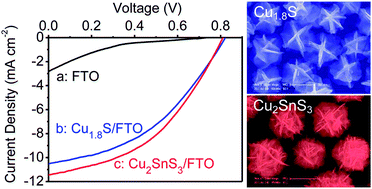Large-scale synthesis of Cu2SnS3 and Cu1.8S hierarchical microspheres as efficient counter electrode materials for quantum dot sensitized solar cells†
Abstract
Exploration of new catalytic semiconductors with novel structures as

* Corresponding authors
a
Department of Physics and Materials Science, Center of Super-Diamond and Advanced Films (COSDAF), City University of Hong Kong, Hong Kong SAR, P.R. China
E-mail:
apcslee@cityu.edu.hk
Exploration of new catalytic semiconductors with novel structures as

 Please wait while we load your content...
Something went wrong. Try again?
Please wait while we load your content...
Something went wrong. Try again?
J. Xu, X. Yang, T. Wong and C. Lee, Nanoscale, 2012, 4, 6537 DOI: 10.1039/C2NR31724A
To request permission to reproduce material from this article, please go to the Copyright Clearance Center request page.
If you are an author contributing to an RSC publication, you do not need to request permission provided correct acknowledgement is given.
If you are the author of this article, you do not need to request permission to reproduce figures and diagrams provided correct acknowledgement is given. If you want to reproduce the whole article in a third-party publication (excluding your thesis/dissertation for which permission is not required) please go to the Copyright Clearance Center request page.
Read more about how to correctly acknowledge RSC content.
 Fetching data from CrossRef.
Fetching data from CrossRef.
This may take some time to load.
Loading related content
